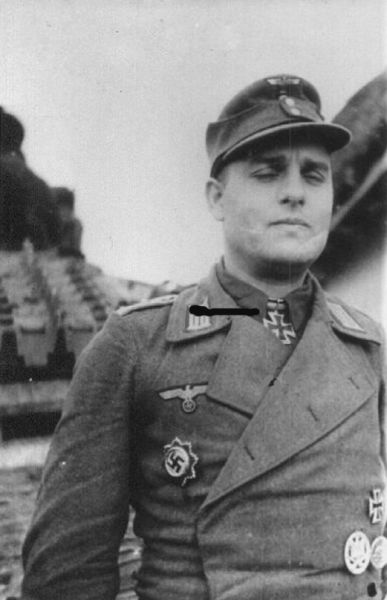Bausch, Albert, Joseph, Dr.jur.
- Date of birth:
- July 2nd, 1904 (Orken, Rhineland, Germany)
- Date of death:
- August 29th, 1944 (near Plaiesii de Jos, Romania)
- Buried on:
- German War Cemetery Jassy / Iasi
Plot: 1A. Row: 10. Grave: 472. - Nationality:
- German
Biography
00.07.1943: Hauptmann d.R.
00.08.1944: Major
00.07.1943: Stab/ Sturmgeschütz-Abteilung 226
22.10.1943-14.02.1944: Kdr - Stab/ Sturmgeschütz-Abteilung 286
14.02.1944-30.08.1944: Kdr - Stab/ Sturmgeschütz-Brigade 286
Do you have more information about this person? Inform us!
- Period:
- Second World War (1939-1945)
- Awarded on:
- June 13th, 1940
- Period:
- Second World War (1939-1945)
- Awarded on:
- October 9th, 1942
- Period:
- Second World War (1939-1945)
- Rank:
- Hauptmann der Reserve (Captain of Reserves)
- Unit:
- Sturmgeschütz-Abteilung 226, Heer
- Awarded on:
- July 4th, 1943
- Period:
- Second World War (1939-1945)
- Rank:
- Hauptmann der Reserve (Captain of Reserves)
- Unit:
- Kommandeur, Sturmgeschütz-Abteilung 286, Heer
- Awarded on:
- February 10th, 1944
After this the 11. and 17. Panzer-Divisionen were taken out of the frontline, and the 2. Fallschirmjäger-Division was ordered to take over the sector of these two divisions. This section of frontline amounted to 21 km, however the Division only had a combat strength of 3200 men to man it. As such the Sturmgeschütz-Abteilung 286 was ordered to remain attached to the Division to provide support.
The Soviets launched a major offensive in this sector on the 05.01.1944. They attacked westwards from Novgorodka and Snamenka in order to envelop and capture Kirovograd. The southern enveloping arm struck the 2. Fallschirmjäger-Division.
Furious fighting ensued, and in this time Bausch’s Sturmgeschütze fought valiantly alongside the Fallschirmjäger. On one occasion Hauptmann Bausch personally launched a counterthrust with 3 Sturmgeschütze and the remains of the 9./Fallschirmjäger-Regiment 2 (some 40 men). This counterthrust was ultimately successful, and the ~600 man strong enemy force in this area was thrown back beyond the German frontline
On this day the Germans claimed a total of 179 tanks destroyed in the sector of the 2. Fallschirmjäger-Division alone. 61 by the II./Flak-Regiment 42, 60 by the Sturmgeschütz-Abteilung 286, 12 by the divisional artillery, 3 by the light infantry gun Zug of the II./Fallschirmjäger-Regiment 5, 34 by the divisional Panzerjäger-Abteilung and 9 by close combat weaponry.
The Soviets continued their attacks in this sector until the 08.01.1943. Although the German frontline was pushed back it did not break. This was in large part due to the efforts of Hauptmann Bausch and his Sturmgeschütze, who repeatedly managed to stabilize critical situations with minimal infantry support.
Hauptmann Bausch would be awarded the Knight’s Cross for both the successes of his unit around Novgorodka and his own personal achievements during the war (which included a tally of 29 tanks destroyed by this time).
- Period:
- Second World War (1939-1945)
- Period:
- Second World War (1939-1945)
- Rank:
- Oberleutnant (1st Lieutenant)
- Unit:
- Battr.Chef, 2. Batterie, Sturmgeschütz-Abteilung 226, Heer
- Awarded on:
- February 22nd, 1943
1613rd Award.
- Period:
- Second World War (1939-1945)
- Period:
- Second World War (1939-1945)
Sources
- Photo 1: Dobri Dobrev
- - DöRR, M., Die Inhaber der Anerkennungsurkunde des Oberbefehlshaber des Heeres 1941-1945, Biblio Verlag, Osnabrück, 1993.
- FELLGIEBEL, W.P., Elite of theThird Reich, Helion & Company Limited, Solihull, 2003.
- PATZWALL, K. & SCHERZER, V., Das Deutsche Kreuz 1941-1945, Band II, Verlag Klaus D. Patzwall, Norderstedt, 2001.
- SCHERZER, VEIT & FARWICK, WERNER, Die Ritterkreuzträger der Sturmartillerie 1939-1945, Verlag Veit Scherzer, 2011.
- THOMAS, FRANZ & WEGMANN, GüNTER, Die Ritterkreuzträger der Deutschen Wehrmacht 1939-1945, Biblio-Verlag, Osnabrück, Germany, 1985.
- Die Sturmgeschütz Abteilungen 1940 - 45
- Axis History Forum via Awardholders / unit
- Die Träger des Deutschen Kreuzes










